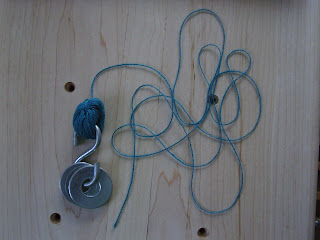Here is the culprit. A lovable little fuzzball? NOT! A bit of fuzz made two of the threads stick together and one broke. If you need to make the photo bigger, just click on it.
Here is the break by the back beam.
The first step is to isolate the broken warp and heddle. This one happened to still be threaded. I used my homemade warp separator, which is simple enough to make, but are available for purchase. Google search warp separator.

Tie the broken end to the repair piece.
I am generous in cutting the repair piece, so I cut mine with enough to finish the towel I was working on plus some extra. How much is needed depends on whether the break is in front of or behind the heddles, and how far into the piece the weaving has progressed.
You don't need enough to finish the entire remaining warp. The object is to get back to using the original warp thread and do away with a dangling weight behind the loom.
Since I am weaving a hand towel that is only about 30" long, I will finish this towel before getting rid of the repair warp and fastening the original warp thread back onto the cloth.
Once the two ends are tied together, I pull the knot through the heddle.
Gently pull the knot through the reed.
I like the flat daisy head pins to attach the broken warp thread to the cloth. Start the pin about 1/4" away from where the warp thread should be and bring the tip up 1/4" from that.
Wrap the repair warp around the pin 2-3 times in a figure eight and then anchor the tip of the pin in the fabric so it is not exposed to draw blood.
Sometimes photos are a good way to find errors. As I was viewing my
photos, I noticed the last orange weft thread wasn't doubled. I was able to go back and fix that error and reset my pin.
Finally, go to the back of the loom and tie the other end of the broken warp to the repair warp. Suspend a weight that gives the same amount of tension as the other warp threads. An "s" hook works for me.
On a little more personal note, I have had one chemo treatment and my hair is gone. It started falling out about nine days ago so I had a friend shave it off. I have been working on crocheting a couple chemo hats (the white and turquoise ones) and my mom knit the pink one for me.
The weather has been pretty warm in Charlevoix, so I have become more comfortable going without a hat. The cool weather will be coming soon though, and I am thankful for all the nice hats and caps friends have given me. They will all get put to good use!
I am feeling fine, my energy is almost back to normal, as is my appetite because my last chemo was over three weeks ago and it has been over six weeks since surgery. I was supposed to get my next treatment yesterday but it was cancelled because my blood count was too low. Hopefully it will be up enough to have the chemo next Thursday. Right now, I am in a self-imposed semi-isolation. I can't afford to get anyone's germs. The up side to that is I am getting a fair amount of weaving done.
Now, back to the loom!





















